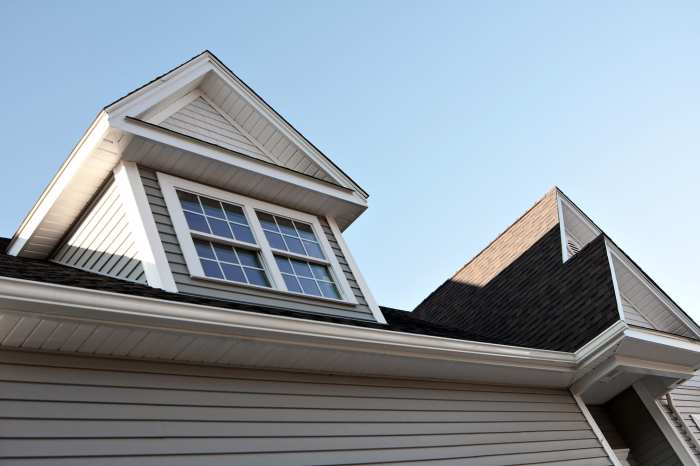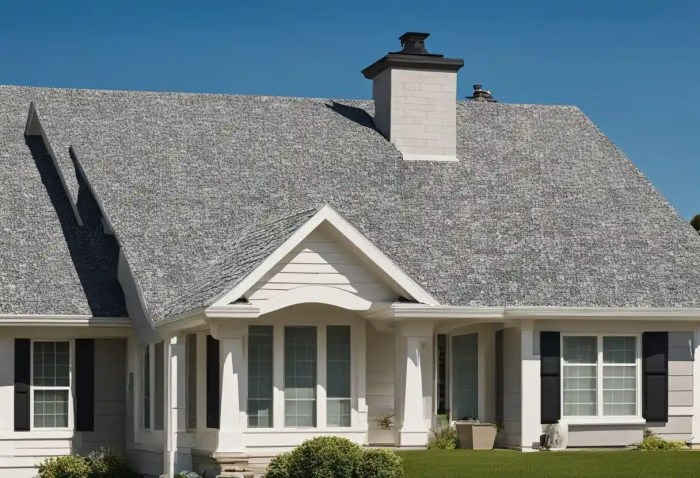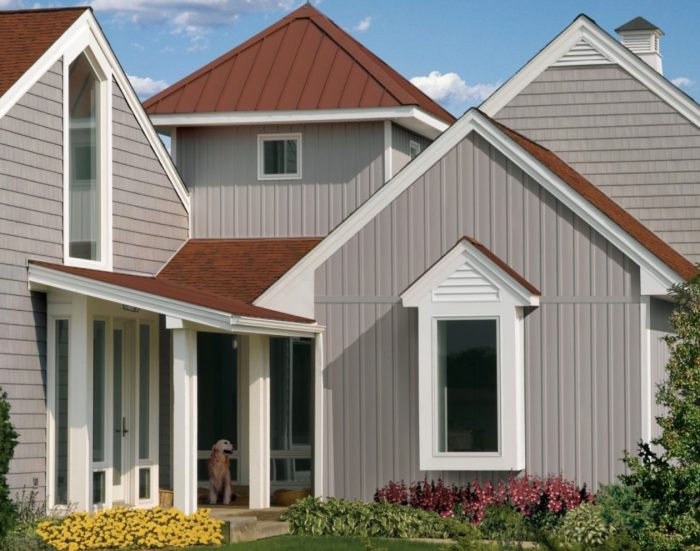Enhancing Buildings with Quality Materials: Exploring the World of Roofing and Siding
Delving into the realm of roofing and siding, this exploration uncovers the importance of these components in enhancing the structural integrity and visual appeal of buildings. From the choice of materials to installation processes, this journey sheds light on the key aspects of roofing and siding.
As we unravel the layers of information, you'll gain valuable insights into the world of roofing and siding, paving the way for informed decisions and a deeper understanding of these crucial elements in construction.
Importance of Proper Roofing and Siding
Proper roofing and siding play a crucial role in the structural integrity and aesthetics of a building. Investing in high-quality materials for these components is essential for ensuring durability, functionality, and visual appeal.
Benefits of Investing in Durable Materials
- Enhanced Protection: Durable roofing and siding materials provide better protection against harsh weather conditions, such as heavy rain, strong winds, and extreme temperatures.
- Longevity: High-quality materials have a longer lifespan, reducing the need for frequent repairs or replacements, ultimately saving costs in the long run.
- Energy Efficiency: Properly installed roofing and siding can improve insulation, leading to better energy efficiency and reduced heating and cooling costs.
Enhancing Building Aesthetics
Aside from the functional benefits, proper roofing and siding can significantly enhance the overall aesthetics of a building. Choosing the right materials, colors, and textures can complement the architectural style and create a visually appealing facade.
Types of Materials for Roofing and Siding
When it comes to roofing and siding, there are various materials to choose from, each with its own set of benefits and drawbacks. It's essential to understand the different materials available to make an informed decision for your property.
Materials for Roofing:
- Asphalt: Asphalt shingles are a popular choice due to their affordability and ease of installation. However, they may not be as durable as other materials and can require more frequent maintenance.
- Metal: Metal roofs are known for their longevity and durability, making them a great option for those looking for a long-term solution. They are also low maintenance and energy-efficient.
- Wood: Wood shingles or shakes provide a natural and rustic look to a property. While they are aesthetically pleasing, they can be prone to rot and require regular maintenance to prevent issues.
- Vinyl: Vinyl siding is a cost-effective option that is easy to maintain and comes in a variety of colors and styles. It is resistant to moisture and can withstand harsh weather conditions.
Materials for Siding:
- Brick: Brick siding is durable and requires minimal maintenance. It offers excellent insulation properties and can last for decades without needing replacement.
- Stucco: Stucco siding is a popular choice for its versatility and fire resistance. It can be applied to various surfaces and provides a durable finish that can withstand weathering.
- Fiber Cement: Fiber cement siding is a low-maintenance option that is resistant to rot, fire, and pests. It comes in a range of textures and colors, mimicking the look of wood or stone.
- Composite: Composite siding is a blend of materials like wood fibers and resins, offering the appearance of wood with enhanced durability and longevity. It is resistant to moisture and insects.
Installation Process for Roofing and Siding
When it comes to installing roofing and siding, following the proper steps is crucial to ensure a durable and secure finish for your home. Here, we will detail the key steps involved in the installation process, provide tips for a successful installation, and discuss common challenges that may arise.
Roofing Installation
Roofing installation is a complex process that requires precision and attention to detail. Here are the steps typically involved:
- Prepare the roof deck by ensuring it is clean, dry, and free of any debris.
- Install underlayment to provide an additional layer of protection against water penetration.
- Apply the roofing material, whether shingles, tiles, or metal, following manufacturer guidelines.
- Finish with flashing around roof penetrations to prevent leaks.
Siding Installation
Installing siding is a critical step in protecting your home from the elements and enhancing its curb appeal. Here's how siding installation is typically done:
- Prepare the walls by inspecting for any damage and ensuring they are clean and smooth.
- Install a moisture barrier to prevent water infiltration and protect the structure.
- Begin installing the siding from the bottom up, ensuring each piece interlocks securely.
- Finish with trim pieces around windows, doors, and corners for a polished look.
Tips for Proper Installation
- Follow manufacturer instructions carefully to ensure proper installation and warranty coverage.
- Use high-quality materials to enhance the longevity and durability of your roofing and siding.
- Consider hiring professional contractors for complex installations to ensure a flawless finish.
Common Challenges and Solutions
- Leakage: Properly seal edges and joints to prevent water infiltration.
- Improper installation: Ensure all components are installed correctly to avoid structural issues.
- Damage during installation: Handle materials with care and seek professional help if needed.
Maintenance and Repair of Roofing and Siding

Regular maintenance is crucial for ensuring the longevity and functionality of your roofing and siding. By following a consistent maintenance schedule, you can identify and address minor issues before they escalate into major problems. Here, we will discuss how to effectively maintain and repair your roofing and siding to keep your home in top condition.
Identifying Common Issues
- Leaks: Look for water stains on your ceiling or walls, as well as damp insulation in your attic.
- Cracks: Inspect your siding for any cracks or gaps where moisture can seep in.
- Rot: Check for signs of rot in wooden components of your roofing and siding, such as soft spots or discoloration.
DIY Repair Techniques
- Leak Repair: Use roofing cement to seal small leaks in your roof, and replace damaged shingles if necessary.
- Crack Fix: Fill cracks in your siding with caulk or sealant to prevent water penetration and further damage.
- Rot Treatment: Remove rotted sections of wood and replace them with new materials to prevent the spread of rot.
Energy Efficiency and Insulation
When it comes to the energy efficiency of a building, roofing and siding play a crucial role. Properly installed and insulated roofing and siding can help in maintaining a comfortable indoor temperature, reducing energy consumption, and lowering utility bills.
Impact of Roofing and Siding on Energy Efficiency
Roofing and siding materials with good insulation properties can effectively regulate the indoor temperature by preventing heat loss during winter and heat gain during summer. This reduces the strain on heating and cooling systems, leading to significant energy savings.
Importance of Proper Insulation
- Proper insulation in roofing and siding helps in creating a thermal barrier, preventing heat transfer between the interior and exterior of the building.
- Insulation also helps in reducing air leaks, improving indoor air quality, and creating a more comfortable living or working environment.
Energy-Efficient Options in the Market
There are various energy-efficient roofing and siding options available in the market, such as:
- Reflective roofs that can reflect sunlight and reduce heat absorption, keeping the building cooler.
- Solar panels integrated into roofing materials to harness renewable energy and reduce electricity costs.
- Insulated siding with foam backing that enhances thermal performance and minimizes energy loss.
- Cool roofs made of materials that have high solar reflectance and thermal emittance, reducing cooling needs.
End of Discussion
In conclusion, the intricate dance between roofing and siding plays a vital role in not just protecting a building but also in elevating its charm and durability. With a focus on quality materials and proper maintenance, the journey towards a well-structured and visually appealing property becomes an achievable reality.
User Queries
What are the benefits of investing in durable materials for roofing and siding?
Investing in durable materials ensures longevity, better protection against elements, reduced maintenance costs, and enhanced property value.
How can I identify common issues like leaks, cracks, or rot in roofing and siding?
Look for water stains, mold growth, peeling paint, or soft spots as indicators of potential issues that require attention.
What types of materials are commonly used for roofing and siding?
Common materials include asphalt, metal, wood, vinyl, and composite materials, each offering unique benefits and aesthetics.




